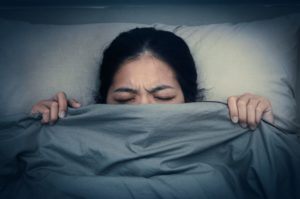Nightmares in Children
Nightmares can occur at any age but studies suggest they are exceptionally common for young children. Roughly half of children between the ages of 3 and 6 report frequent nightmares. The same is true for 20 percent of children ages 6 to 12. While most children eventually outgrow their nightmares, some may develop nightmare disorder , a condition characterized by recurring unpleasant or frightening dreams that cause sleep disturbances. Night terrors, outbursts during sleep that can last for several minutes, are also more common in children than adults.
In this guide, we’ll look at the root causes behind kids’ nightmares at different ages and discuss some strategies parents can use to help their children process their bad dreams.
How Nightmares Affect Children
Nightmares primarily occur during rapid eye movement (REM) sleep, the final stage of a normal human sleep cycle. REM sleep is more prevalent during the middle of the night or early morning, so children are more likely to wake up from a nightmare at these times.
Nightmares manifest differently for each child, but they often include scary elements such as monsters, ghosts, aggressive animals, or people who pose a threat to their safety. Other nightmares may involve the child being scolded, harassed, bullied, or otherwise mistreated.
In the throes of a nightmare, most children will be relatively non-responsive. Vocalizations, movements, and autonomic symptoms such as rapid breathing, perspiration, or dilated pupils are uncommon for children having bad dreams. Many children feel helpless or anxious upon waking up, and this can cause their heart rate to speed up dramatically. Over time, children who frequently experience nightmares can develop insomnia symptoms linked to feelings of dread over falling asleep and having a bad dream.
Studies and surveys have yielded different findings regarding the prevalence of nightmares for different age groups. However, this research suggests a peak in nightmares for children between the ages of 3 and 6, as well as those aged 5 to 9. Infant and toddler nightmares have been documented, but are believed to be not as common – though the majority of studies regarding children and nightmares have focused on subjects aged 5 and older. Nightmares appear to affect both sexes equally up to age 12, but some studies indicate bad dreams are more prevalent for girls beginning at age 13.
Nightmares vs. Night Terrors
Nightmares are often mistaken for night terrors, which are defined as episodes of terror and panic that occur during sleep. A single episode can last up to 90 minutes. Unlike nightmares, night terrors are often accompanied by vocalizations, autonomic symptoms, and other signs the child is acting out against the dream. Another key difference is night terrors primarily occur during the non-rapid eye movement (NREM) stages, whereas nightmares mostly take place during REM sleep.
Because they involve unusual behaviors during sleep, night terrors are considered a type of parasomnia. Night terrors are most common in children ages 3 to 7, and typically begin to taper off after age 10. Roughly 30 percent of children experience night terrors, whereas night terrors are much rarer for adults. Some studies suggest a link between adult night terrors and neurologic disorders, but more research is needed to cement this.
Many people who experience night terrors also sleepwalk, and research suggests a higher risk of night terrors if the child or adult has a family history. Counseling, anticipated awakening, and addressing underlying medical issues or stress is part of treatment. In severe cases, doctors may prescribe medication to reduce night terror episodes. Therapy may be recommended for severe cases. While medication is generally discouraged, selective serotonin reuptake inhibitors (SSRIs) may be prescribed due to the widespread belief that night terrors are linked to serotonin levels.
Beyond these treatment methods, reassurance and education are considered the most effective methods of reducing night terror episodes. The prognosis is good for the majority of children diagnosed with night terrors who receive proper intervention.

How to Help Children Cope with Nightmares
For children who experience occasional nightmares, reassurance is often the most effective tactic. Parents should discuss fears and anger triggers with their children in a relaxed setting. This can help promote feelings of relaxation before bedtime, which in turn may improve their sleep quality and minimize their risk of disruptive dreams.
That said, too much reassurance can have the opposite effect. Parents can encourage their children to comfort themselves after waking up from a bad dream as opposed to relying on their family members for comfort. Co-sleeping with children after a nightmare occurs or remaining in their room until they return to sleep are generally frowned upon because these practices have been linked to an increase in nighttime waking episodes for infants and young children.
Parents may find more success by providing a “sleep partner” for their children, typically in the form of a doll or stuffed animal . They may tell the child that the sleep partner is scared, requiring the child to comfort it at night, or that the sleep partner is capable of protecting the child; both intervention strategies can assuage nighttime fears and improve the child’s sleep quality. Another effective technique can be to educate children about the reality of nightmares – i.e., they are just thoughts and completely harmless – in order to dispel misconceptions they may have about these dreams. Deep breathing, muscle relaxation, and other coping techniques may also help children sleep more soundly.
When to See a Doctor
Parents should consider a psychological evaluation for their child if he or she experiences at least two nightmares per week for at least six months. Additionally, frequent nightmares in children older than six years may necessitate psychological intervention. Counseling may be recommended. If the child takes medication, their dosage may need to be adjusted.
For some children and adolescents, frequent nightmares stem from sexual assault, abuse, and other types of trauma . Children diagnosed with pediatric post-traumatic stress disorder (PTSD) may respond well to imagery rehearsal, a type of therapy during which children “rehearse” less frightening dreams during the day in order to promote more positive dreams at night and decrease nightmares. Medications available to adults with PTSD are generally discouraged for children.
Children who experience frequent nightmares may develop anxiety about sleep. They often act out by delaying bedtimes or demanding to co-sleep with their parents. Granting these requests can exacerbate the problem and solidify the child’s worries about sleeping, rather than alleviating them. A strict bedtime schedule, reward-based positive reinforcement, and other behavioral strategies are considered more effective. If these methods are not successful, a low-dose prescription of benzodiazepine may also be recommended.
References
8 Sources
-
McNamara, P. (2016, October 30). Children’s Dreams and Nightmares. Psychology Today., Retrieved from
https://www.psychologytoday.com/us/blog/dream-catcher/201610/childrens-dreams-and-nightmares -
American Academy of Sleep Medicine. (2008). Nightmares & Other Disturbing Parasomnias., Retrieved from
https://aasm.org/resources/factsheets/nightmareparasom.pdf -
Leung, A. K. C., & Robson, W. L. M. (1993). Nightmares. Journal of the National Medical Association, 85(3), 233–235., Retrieved from
https://www.ncbi.nlm.nih.gov/pmc/articles/PMC2571879/pdf/jnma00293-0097.pdf -
Simard, V., Nielsen, T., Tremblay, R., Bolvin, M., & Montplaisir, J. (2008). Longitudinal Study of Bad Dreams in Preschool-Aged Children: Prevalence, Demographic Correlates, Risk and Protective Factors. Sleep, 31(1), 62–70., Retrieved from
https://www.ncbi.nlm.nih.gov/pmc/articles/PMC2225564/ -
Van Horn, N. L., & Street, M. (2021, July 10). Night terrors. In StatPearls. StatPearls Publishing., Retrieved from
https://www.ncbi.nlm.nih.gov/books/NBK493222/ -
Kushnir, J., & Sadeh, A. (2011). Assessment of brief interventions for nighttime fears in preschool children. European Journal of Pediatrics, 171(1), 67–75., Retrieved from
https://pubmed.ncbi.nlm.nih.gov/21594575/ -
Kennedy-Moore, E. (2016, January 13). How to Help Kids with Nightmares. PBS Kids for Parents., Retrieved from
https://www.pbs.org/parents/thrive/how-to-help-kids-with-nightmares -
Moturi, S., & Alvis, K. (2010). Assessment and treatment of common pediatric sleep disorders. Psychiatry (Edgmont), 7(6), 24–37., Retrieved from
https://www.ncbi.nlm.nih.gov/pmc/articles/PMC2898839/













